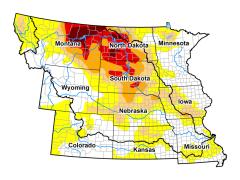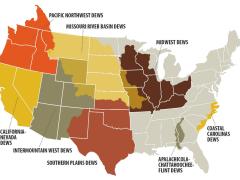Got Drought? Let the Drought Impact Reporter Know

BROOKINGS, S.D. - Agricultural producers are encouraged to share drought impact information through the Drought Impact Reporter, part of the National Drought Mitigation Center.
The Reporter allows producers to report local drought impacts and conditions. The tool was developed by the U.S. Department of Agriculture (USDA) in partnership with the National Oceanic and Atmospheric Administration and the University of Nebraska in Lincoln. NIDIS funding helps supports this effort.
"The current drought has had a devastating impact on many South Dakota farmers and ranchers. We need individuals to share information on the conditions they see on their farms and ranches through the proper channels so all information can be reviewed and valuable information is not lost," said Laura Edwards, South Dakota State University Extension State Climatologist.
As state climatologist, Edwards provides recommendations which are utilized by the author who is developing the U.S. Drought Monitor map and assigning drought designations.
"Much of the recommendation is based on water and climate data which we as a team pull from weather stations, satellites, stream gauges and other tools. However, we also use information from impact reports, provided by landowners," Edwards said.
These impact reports are pulled from the Drought Impact Reporter website.
"It is so important that South Dakota's farmers and ranchers share information of the impact this drought is having on their land and livestock through this website," said Mike Jaspers, South Dakota Secretary of Agriculture. "The Drought Monitor can only be as accurate as the data used to write it. The more people sending in reports, the more data points the authors have to get a clear and complete picture of conditions on the ground."
For those not familiar with drought designations and why a specific designation matters to South Dakota's agriculture producers, it comes down to disaster relief funding.
A few disaster relief programs, provided through the USDA, Farm Service Agency (FSA) base eligibility on the drought designation assigned to specific counties.
"FSA does not report information to the authors of the U.S. Drought Monitor; we simply rely on the information for program purposes," explained Jamie White, Acting State Executive Director, Executive Officer, USDA-FSA, South Dakota. "For producers concerned about the integrity of the U.S. Drought Monitor, the best thing they can do is provide a complete report of weather conditions through the reporting tool designated for producers. The Drought Impact Reporter streamlines the information provided to the authors of the U.S. Drought Monitor."
More about Drought Impact Reporter
Producers supplying impact information to the U.S. Drought Monitor process can click on the “Submit Report” tab above the map on the Impact Reporter website. This report allows producers to:
- Provide a written description of drought impacts on livelihood, activities, etc.;
- Select categories to show losses and gains as a result of the drought;
- Report on the duration of drought event;
- Select Affected Places - geographic areas ranging from an entire state to a small area within a state;
- Submit images that document the drought and its impact;
- Provide contact information (includes an option to keep information confidential).
Find out more about how the U.S. Drought Monitor determines drought intensity classifications







